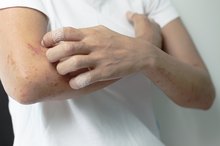Hydrochlorothiazide & Itchy Skin
Hydrochlorothiazide, also known as Microzide in the United States and Apo-Hydro and Novo-Hydrazide in Canada, is a medication used to treat high blood pressure. Considered a diuretic, hydrochlorothiazide lowers blood pressure and eliminates excess salt and water in your body through the kidneys. It boosts your production of urine. Some people who take hydroclorothiazide have a photosensitivity reaction triggered by exposure to ultraviolet light, or sunlight. One of the symptoms of this reaction is itchy skin.
Phototoxic Reaction
Some 95 percent of photosensitive reactions due to hydroclorothiazide are considered phototoxic, Dr. Miriam Lindrooth explains 2. If your skin turns red, swells and burns after minutes or hours of exposure to sunlight, you are experiencing a phototoxic reaction. The reaction mirrors sunburn and is localized to only the skin that was exposed to ultraviolet light. If you have a severe reaction, your skin may break into hives and blister. If you stop taking hydroclorothiazide, these symptoms will typically vanish within two to seven days.
- Some 95 percent of photosensitive reactions due to hydroclorothiazide are considered phototoxic, Dr. Miriam Lindrooth explains 2.
- If your skin turns red, swells and burns after minutes or hours of exposure to sunlight, you are experiencing a phototoxic reaction.
Photoallergic Reaction
Can Milk Thistle Cause Skin Rashes?
Learn More
If you have a photoallergic reaction to the sun, it will occur 24 to 72 hours after exposure to ultraviolet light. The reaction may spread to areas of body that were not exposed. The symptoms resemble eczema. Your skin will become very itchy. The cause of a photoallergic reaction stems from the antibodies that your body produces when you take hydroclorothiazide, which makes your skin ultrasensitive to the sun. If you stop taking hydroclorothiazide, the symptoms will disappear.
- If you have a photoallergic reaction to the sun, it will occur 24 to 72 hours after exposure to ultraviolet light.
- The cause of a photoallergic reaction stems from the antibodies that your body produces when you take hydroclorothiazide, which makes your skin ultrasensitive to the sun.
Treatment
Apply topical corticosteroids, such as hydrocortisone cream, to the affected areas of your skin. You can also use soothing lotions and cool compresses to relieve any inflammation or swelling. Oral antihistamines will ease the itching. If you’re unable to stop taking hydroclorothiazide because it will put your health at risk, check with your doctor to see if you can switch to evening doses.
- Apply topical corticosteroids, such as hydrocortisone cream, to the affected areas of your skin.
Preventive Measures
Tamarind Spice Allergy
Learn More
Avoid direct sunlight, particularly during the midday hours when the sun is the strongest. Wear a hat and sunglasses and other protective garb to shield your skin. Apply sunscreen with an SPF of 15 or more and use protective lip balm. Avoid using tanning beds or sun lamps.
- Avoid direct sunlight, particularly during the midday hours when the sun is the strongest.
- Apply sunscreen with an SPF of 15 or more and use protective lip balm.
Related Articles
References
- NYU Langone Medical Center; Diuretics; Karen Schroeder Kassel, M.S., R.D., M.Ed.
- University of Colorado Hospital; Drug Induced Photosensitivity — Drugs and Sun Don’t Mix; Miriam Lindrooth, M.D.; 2010
- Goetze S, Hiernickel C, Elsner P. Phototoxicity of doxycycline: a systematic review on clinical manifestations, frequency, cofactors, and prevention. Skin Pharmacol Physiol. 2017;30(2):76-80. doi:10.1159/000458761
- Loh TY, Cohen PR. Ketoprofen-induced photoallergic dermatitis. Indian J Med Res. 2016;144(6):803-806.doi:10.4103/ijmr.IJMR_626_16
- Answer provided in part by Scott J. Zashin, MD, clinical assistant professor at University of Texas Southwestern Medical School, Division of Rheumatology, in Dallas, Texas, and an attending physician at Presbyterian Hospitals of Dallas and Plano.
- Marshall, J., Drug Induced Photosensitivity, PhD Pharmacy Letter, vol.14 no.7 p.25
Writer Bio
Kay Tang is a journalist who has been writing since 1990. She previously covered developments in theater for the "Dramatists Guild Quarterly." Tang graduated with a Bachelor of Arts in economics and political science from Yale University and completed a Master of Professional Studies in interactive telecommunications at New York University.









